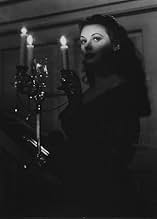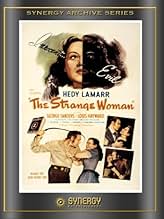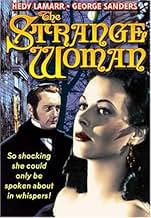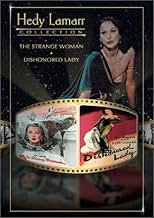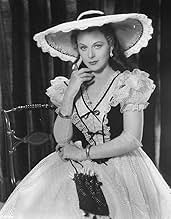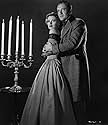Dans la Nouvelle Angleterre des années 1820, Jenny Hager, une femme aussi belle que démunie et manipulatrice, épouse le richissime Isaiah Poster, mais séduit aussi son fils et son contremaît... Tout lireDans la Nouvelle Angleterre des années 1820, Jenny Hager, une femme aussi belle que démunie et manipulatrice, épouse le richissime Isaiah Poster, mais séduit aussi son fils et son contremaître.Dans la Nouvelle Angleterre des années 1820, Jenny Hager, une femme aussi belle que démunie et manipulatrice, épouse le richissime Isaiah Poster, mais séduit aussi son fils et son contremaître.
- Réalisation
- Scénario
- Casting principal
- Congregation Member
- (non crédité)
- Congregation Member
- (non crédité)
- Sailor in Saloon
- (non crédité)
- Mrs. Thatcher
- (non crédité)
- Congregation Member
- (non crédité)
- Mr. Partridge
- (non crédité)
Avis à la une
If you can put aside the fact that the lead character has a Viennese accent and her father an Irish one when they are both lifelong natives of Bangor, Maine then there is much to enjoy. Hedy, stunningly beautiful as always, plays a deeply conflicted woman well and though the film veers wildly from morality tale to lurid melodrama it is certainly more fun than a lot of more highly thought of films.
The movie's got the gloss and the casting of a top studio production, maybe TCF. But it's not. Instead, the film is an independent production with Lamarr as a co-producer. I mention this because the result looks tailor-made for a Lamarr career move; at the same time, she does manage to prove she's more than just Hollywood's perfect face. Here, her conniving little vixen (Jenny) transits a number of emotional stages and male victims in fairly convincing style. However, unless I missed something, Jenny's inner guile fails to show up in any of the many close-ups. As a result, Jenny's deceit remains mainly in the script—the one performance flaw.
The movie itself is an atmospheric potboiler, thanks to stylist Edgar Ulmer and art director Remisoff. The scenes may remain stage-bound, but the overall effect is compelling, a triumph of b&w expressiveness. Note too how the scenes get steadily darker as the film progresses and Jenny gets closer to the expected reckoning. Even when the screenplay meanders, which does slow things down, the visuals remain smoothly engaging. Then too, the logging camp setting should have been rethought. The sophisticated Sanders is simply not an outdoor type. Still, wonder of wonders, two of cinema's favorite cerebral baddies, Sanders and Brooke, get sympathetic roles, for a change. Actually, I expected Sanders to break into a cynical sneer at any moment, and maybe Brooke to revert to type with an icy glare. Anyway, it is an interesting cast, down to Hayward as the weakling Ephraim and little Jo Ann Marlowe as the meanest girl since Patty McCormack's Bad Seed (1956).
I don't know if the film resulted in the kind of career break Lamarr was likely looking for, but it remains an entertaining morality tale, despite a spotty script and stage-bound settings.
This may be Hedy Lamarr's most challenging role, and she acquits herself quite well. George Sanders appears infrequently as a sympathetic character, but even he is victimized by the Scarlett O'Hara-like wiles of Hedy. That both of these performers have accents that are not suggestive of born-and-bred Maine residents should not constitute more than a minor annoyance. The picture has more than enough offsetting merits.
Le saviez-vous
- AnecdotesExecutive producer Hunt Stromberg declared his dissatisfaction with the original opening sequence of Edgar G. Ulmer's own daughter Arianne Ulmer, who played the young Jenny; she purportedly was not nasty enough. So he and Hedy Lamarr enlisted Douglas Sirk to reshoot the scenes using Jo Ann Marlowe, who had appeared in Sirk's Scandale à Paris (1946) earlier that year, and who also had featured as Joan Crawford's daughter Kay in Michael Curtiz' Le roman de Mildred Pierce (1945).
- GaffesEphraim paints "Nöel" rather than the correct "Noël".
People often make spelling mistakes, especially where diacritical marks are concerned.
- Citations
Lena Tempest: Honey, listen, with your looks you don't have to worry. You can get the youngest and best-looking man on the pier.
Jenny Hager: I don't want the youngest. I want the richest.
- Versions alternativesLe démon de la chair (1946). Restoration Produced by Jeff Joseph/SabuCat. Digital scan by Film & Video Transfer, Chatsworth, CA. Cineaste Restoration - Thad Komorowski.. Final Conforming & Cleanup by The Finishing Touch. The Strange Woman (Restored Version) copyright 2020 Jeff Joseph/SabuCat.
- ConnexionsFeatured in Edgar G. Ulmer: The Man Off-Screen (2004)
- Bandes originalesWhat Can You Do with a Drunken Sailor?
Traditional
Early 19th Century sea chanty
[Heard in tavern]
Meilleurs choix
- How long is The Strange Woman?Alimenté par Alexa
Détails
- Date de sortie
- Pays d’origine
- Sites officiels
- Langue
- Aussi connu sous le nom de
- Flor de insidia
- Lieux de tournage
- Sociétés de production
- Voir plus de crédits d'entreprise sur IMDbPro
- Durée
- 1h 40min(100 min)
- Couleur
- Rapport de forme
- 1.37 : 1

